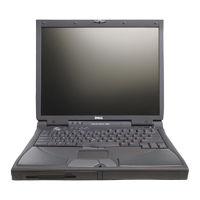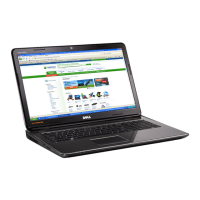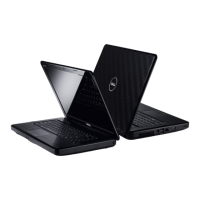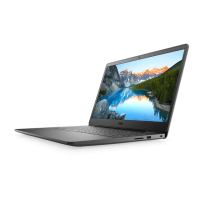




Do you have a question about the Dell Inspiron 8200 and is the answer not in the manual?
Defines system alerts like HINT, NOTICE, and CAUTION for user guidance.
Details the components visible on the front of the computer.
Identifies ports and features on the left side of the computer.
Details ports and features found on the right side of the laptop.
Illustrates and labels the connectors and ports on the back of the computer.
Shows and labels components located on the underside of the computer.
Guides users on how to access built-in help resources and documentation.
Provides troubleshooting steps for issues related to the computer's power supply and battery.
Explains common error messages that appear during system startup.
Offers solutions for issues concerning the computer's screen and video output.
Helps resolve issues related to the computer's audio output and speakers.
Provides guidance for troubleshooting common printer connectivity and functionality issues.
Addresses troubleshooting for modem and network connectivity issues.
Offers solutions for common problems encountered with scanner operation.
Guides users on troubleshooting issues with the touch pad and external mouse.
Provides steps for resolving problems associated with external keyboards.
Explains how to resolve issues where unexpected characters appear on the screen.
Offers solutions for issues related to floppy, CD, DVD, and hard drives.
Provides troubleshooting steps for issues related to PC Card installations and functionality.
Offers guidance for resolving issues with network connectivity and performance.
Explains how to interpret and resolve various system error messages.
Provides solutions for common issues encountered with software applications.
Guides users on troubleshooting common issues with email client setup and usage.
Offers general advice for resolving various technical difficulties not covered elsewhere.
Provides critical safety and drying procedures for water-damaged computers.
Offers initial steps to take after the computer has been physically damaged.
Advises on the appropriate situations for running hardware diagnostic tests.
Highlights the capabilities and benefits of the Dell Diagnostic utility.
Provides step-by-step instructions for initiating the diagnostic software.
Details advanced features for customizing and performing specific hardware tests.
Explains how diagnostic results relate to the computer's system configuration.
Provides instructions for reinstalling drivers from the provided CD or Dell support site.
Offers methods to diagnose and resolve conflicts between hardware and software.
Explains how to use Windows System Restore to revert the system to an earlier state.
Introduces the purpose and basic functionality of the system setup program.
Guides users on navigating and understanding the different screens within the BIOS setup.
Describes the layout and information presented on system setup screens.
Details frequently accessed settings within the system setup utility.
Provides core system details like chipset, memory bus, and graphics bus.
Details specifications for the PC Card slot and supported cards.
Lists memory architecture, module types, capacities, and speeds.
Describes the types and pin assignments of various I/O ports on the computer.
Details specifications for the modem, network adapter, and wireless capabilities.
Outlines the details of the video controller, memory, and display interface.
Lists specifications for the audio controller, speakers, and interfaces.
Provides details on screen type, dimensions, resolutions, and response times.
Details the number of keys, travel, spacing, and layout of the keyboard.
Lists resolution, size, and other specifications for the touch pad.
Details the specifications for the integrated track stick pointing device.
Lists battery type, capacity, dimensions, and weight.
Provides input/output voltages, current, power, and dimensions of the AC adapter.
Lists the physical dimensions and weight of the computer.
Details operating and storage conditions, including temperature and humidity.
Offers advice for maximizing battery life and efficient power usage.
Describes standby and hibernate modes for power conservation.
Guides users on configuring detailed power settings through Windows control panel.
Shows the pinout for the Universal Serial Bus (USB) connector.
Details the pin configuration for the RS-232 serial port connector.
Shows the pinout for the parallel port, typically used for printers.
Details the pin configuration for the VGA video output connector.
Shows the pin assignments for the PS/2 keyboard and mouse ports.
Details the pinout for the S-Video output connector.
Shows the pin configuration for the docking station interface.
Details the pinout for the IEEE 1394 (FireWire) connector.
Covers essential safety precautions and preparation steps before working on the computer.
Identifies the major internal hardware components of the computer.
Guides on removal and replacement of the hard drive and optical drive.
Explains how to upgrade memory modules and install other expansion cards.
Provides detailed steps for removing and reinstalling the computer keyboard.
Guides on how to replace the computer's display assembly and its components.
Details the procedure for safely removing and installing the microprocessor.
Explains how to remove and replace the computer's video graphics board.
Guides on how to remove and replace the palm rest assembly.
Details the procedure for replacing the internal reserve battery.
Provides instructions for removing and installing the main system board.
Guides on replacing the latches for the battery and module bays.
Explains how to remove and replace the battery charger board.
Details the procedure for replacing the LED indicator board.
Guides on how to remove and replace the system cooling fan.
Provides instructions for replacing the modem and network port module.
| Processor | Intel Pentium 4-M |
|---|---|
| Hard Drive | 20 GB to 60 GB |
| Chipset | Intel 845MP |
| Display | 15-inch UXGA (1600x1200) or 14.1-inch XGA (1024x768) |
| Operating System | Windows XP Home, Windows XP Professional |
| Battery | 8-cell Lithium-ion |
| Optical Drive | DVD-ROM |
| Ports | S-Video, Parallel, Serial, VGA |
| Wireless | 802.11b |
| Maximum Resolution | 1600x1200 |












